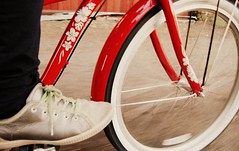![]() photo credit: markhillary
photo credit: markhillary
Today there was a very interesting opinion piece on the New York Times website. The piece is titled “Do We Tolerate Too Many Traffic Deaths?” The article points out that while traffic-related deaths are at a lower number than they have been for years, traffic-related deaths are still the #1 killer of citizens in the U.S.A. between the ages of 1-34.
The number of deaths per year from auto accidents is right around 40,000. Many experts added their opinion to the question to help shed some light on our tolerance. Here are a few of my favorites.
“The U.S. leads large Western nations in traffic fatalities. Every year, we sacrifice nearly 40,000 people — children, parents and other vulnerable road users. Better cars, air bags, seat belts, improved highway design, law enforcement, they all help. But still we lag. Why? In short, because we have built our communities for cars, not people. And many of us haven’t realized that we can do far better.” Dan Burden Executive Director Walkable Livable Communities Institute.
“Let us not forget, however, that over the past 25 years, more than one million men, women and children died in traffic crashes in this country. If we had lost this many people to war or famine, Americans would be demanding swift action. Clearly, what some have called the “disease of mobility†deserves more serious attention.
One death from a traffic crash is unacceptable. One death every 13 minutes, the historical average in the U.S., is outrageous. Unfortunately, our society is not outraged. Instead, for the most part, we accept these tragedies as the cost we pay for the mobility we enjoy.” J Peter Kissinger President and Chief Executive Officer of AAA Foundation For Traffic Safety.
“You can point your finger in almost any direction and find a cause for a level of road fatalities in the United States that — if beneath historic highs — nevertheless remains so elevated that were it a disease, contagion or environmental disaster people would be marching in the streets and raising money door to door.” Jamie Kitman New York Burea Chief for Automobile Magazine (no link for moral reasons 🙂 )
I would really encourage everyone to head over to the NY Times and take a look at the comments in full. There is a lot of really good advice and sentiment on this issue. Many of the comments call for action and reformation on how our cities are built and how often we drive. Do I think that everyone in every case can or should go with out a car? No. Do I think that our transportation system is car-centric and leading us to an even more car-dependent future? Yes. Do I think this is an unstable and stalled approach? YES! Do I think that bicycles, cars, pedestrians, and transit can and should live in cooperation? Yes.
The American city has been designed and built for cars. By staying with old design and engineering methods we are giving up our public space and building cages of asphalt and concrete that will only allow us to see the world from behind a steering wheel which for some of us or for those we know, will lead to an early and unfortunate end. The best part is we are asking for this to happen since our silence is deafening. We have said it once and we will say it again and again: If you do not want to see this happen to Provo (this is the way we are headed with the projects that have been approved for the next few years), contact your City Council Members let them know you ride your bike. Let them know that being able to walk or bicycle to a destination safely is important and that you would like to see them represent your view. If after contacting your Council Member they still do nothing for your view then when elections come up again make sure they do not get your vote. Healthy communities are built on healthy citizens and a balanced use of resources. What type of Provo are we going to build?

![]() photo credit: half alive♦
photo credit: half alive♦


Thanks for this eye-opening post, Zac. I knew that traffic-related deaths were high, but I never thought of the issue quite in these terms.
It’s true that if some other issue or disease were killing that many people, we would definitely be more active in seeking change.